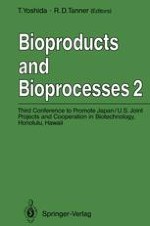1993 | OriginalPaper | Buchkapitel
Development of Micro—Biosensors for Brain Research
verfasst von : Eiichi Tamiya, Isao Karube
Erschienen in: Bioproducts and Bioprocesses 2
Verlag: Springer Berlin Heidelberg
Enthalten in: Professional Book Archive
Aktivieren Sie unsere intelligente Suche, um passende Fachinhalte oder Patente zu finden.
Wählen Sie Textabschnitte aus um mit Künstlicher Intelligenz passenden Patente zu finden. powered by
Markieren Sie Textabschnitte, um KI-gestützt weitere passende Inhalte zu finden. powered by
Neurotransmitters play important roles in the brain since they are the key link in communication between neurons. Acetylcholine is the transmitter of motor neurons in the spinal cord as well as in all the nerve-sketal junctions in vertebrates. It is located diffusely throughout the brain. The activity of the enzyme choline acetyltransferase in the brain decreases often significantly with age. This is the enzyme responsible for synthesis of acetylcholine. Glutamate is also the transmitter which is related to expression of long term memory. Mechanisms of long-term potentiation (LTP) in the hippocampus and long-term depression (LTD) in the cerebellar cortex are unclear because of difficulty in measuring glutamate release from the presynaptic membrane and the sensitivity of the glutamate receptor in the postsynaptic membrane. In vivo acetylcholine and glutamate sensors are powerful tools for elucidating the sites of action in the brain where they operate. A smaller electrode does less damage to tissue during insertion into brain or nerve tissue. An extremely small environment can be examined with a microelectrode whose diameter is of the order of a few micrometers. The carbon fiber electrode is considered to be one of the most useful transducers for in vivo biosensors, because carbon fibers provide us with ultramicroelectrodes with high strength and electrochemically pretreated fibers have a much greater sensitivity to dopamine and catecholamine. Acetylcholine and glutamate cannot normally be directly oxidized on the electrode, however the application of carbon fibers has proven otherwise using immobilized enzymes. Several acetylcholine sensors have been developed based on enzyme electrodes with a potentiometric detector or amperometric detection of oxygen and hydrogen peroxide. However these sensors are not suitable for in vivo analysis. The detection of hydrogen peroxide is an established approach to the construction of biosensors based on electrodes containing immobilized oxidases. In a report by Akiyama it was shown that it is possible to obtain a high sensitivity and an excellent reproducibility to dopamine using microcomputer-controlled potentiostatic pulse polarization techniques [1].
